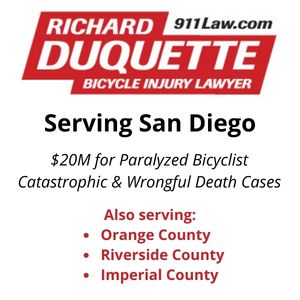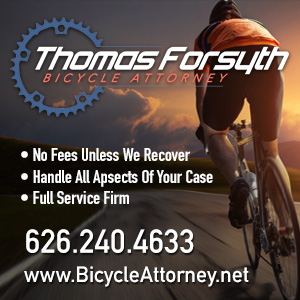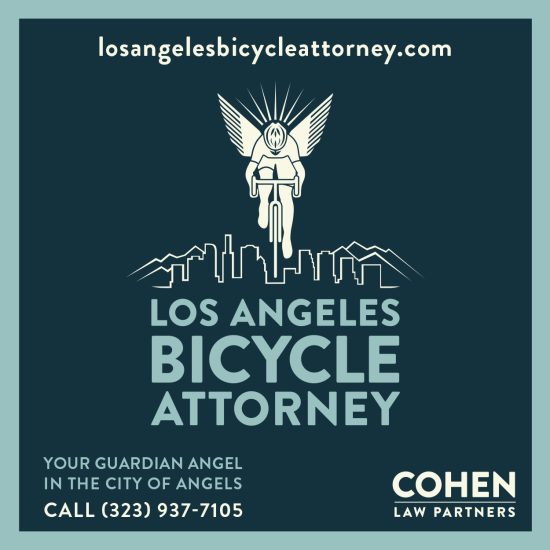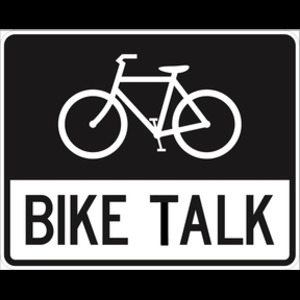
This is why people continue to die on our streets.
A man in Coronado plowed into four people riding their bicycles in a bike lane after having an undisclosed “medical issue” while driving.
Three of the bike riders were taken to the hospital, with injuries described as ranging from minor to serious.
The other rider declined medical treatment — as did the driver, even though he was unresponsive when police arrived.
So his condition is serious enough that he can pass out behind the wheel, but not so serious he needs medical attention afterwards.
And presumably, he was allowed to leave on his own, without so much as a ticket, despite putting three people in the hospital.
Because, you know, a medical condition.
Hopefully, someone will stop him from driving before it happens again. But don’t count on it.
Thanks to Phillip Young for the link.
………
In yet another sign of the times we’re living in, a San Francisco man faces hate charges after assaulting a preteen boy.
The 12-year old victim was riding his bike to Walgreens with his friends when he stopped to help a woman who was sobbing in the parking lot.
It was then that 29-year-old Brendon Kruse “ran up to him and began screaming epithets,” according to SFist.
Though the victim’s friends ran away, the boy held tight — perhaps because Kruse prevented the victim from taking his bike — while Kruse continued yelling insults at him; Kruse at one point showed his lightning bolt and skull tattoos and explained to the boy they meant he “kills [plural n-word].” Kruse allegedly also threatened to kill the boy.
Kruse faces well-deserved charges for “criminal threats, child endangerment and false imprisonment with hate crime enhancements.”
Seriously, there’s not a pit deep enough for someone who could do that.
And something tells me we know who made the woman cry, too.
Note, I would have linked to the original story in the San Francisco Chronicle, except for their paywall.
………
While we’re on the subject of race, Velo Club La Grange, LA’s longtime leading cycling club, is taking a big step towards understanding what it means to bike while Black in the City of Angels.
On Tuesday, July 7th at 7 pm PT, La Grange will be hosting a virtual Town Hall where a number of local Black cyclists have agreed to share their perspective and experiences and then engage in an interactive question and answer session. The Town Hall is open to all. We invite you all to attend and hope you will join us for this critically important conversation. Please feel free to share with fellow cyclists and anyone interested!
The Town Hall meeting will take place online on Tuesday, July 7 @ 7pm; click here for access to the Zoom meeting.
You can read the club’s Full Anti-Racism Statement here.
Thanks to Jaycee Cary for the heads-up.
………
Meanwhile, the World Economic Forum takes a look at the problems faced by Black bike riders in the US, and how bicycling could help drive racial equality, saying “It is time to dissociate racialist culture and bicycle culture; cycling in itself is agnostic to any culture.”
………
This is who we share the road with.
A Seattle man faces two counts of vehicular assault for driving the wrong way up an offramp, around a road closure barrier installed by the state police, and onto a freeway that had been closed for a protest over police brutality.
He swerved around several cars that had been parked across the roadway to serve as barricades, and slammed into two of the protesters.
Twenty-four-year old Summer Taylor was killed, while another person remains in serious condition at a Seattle hospital.
But we can probably all take a guess.
………
A Friday town hall will discuss SB 288, a California state senate bill that would exempt bike and pedestrian projects from CEQA requirements.
What is SB288 and how can it create an equitable, affordable and sustainable transportation system? Join us in a town hall with @Scott_Wiener, @SVLeadershipGrp and @BayAreaCouncil on July 10 at 12:30pm.https://t.co/gb8KMZ0i2z
— SPUR (@SPUR_Urbanist) July 3, 2020
………
David Drexler forwards this opportunity to put your favorite transportation modality where your mouth is.
No, literally.

………
Forget bike polo.
Cycle ball is the weirdest sport you've probably never heard of pic.twitter.com/GpC6bxK8Yx
— Mashable (@mashable) June 30, 2020
………
The war on cars may be a myth, but the war on bikes just keeps going on.
Horrible story from the UK, where a woman riding a mountain bike was attacked and severely beaten by a 60-something man wielding a six-foot long stick. Thanks to Megan Lynch for the link.
………
Local
CicLAvia is now part of the Highline Network, which credits the organization with building a “unifying social fabric,” rather than permanent infrastructure.
State
She gets it. A Bakersfield columnist says the Slow Street movement slowly making its way through the state could change our cities for the better, permanently.
No surprise here, as the annual Sea Otter Classic has gone virtual for 2020.
A nearly $25 million state grant will build 74 low income apartments in Modesto, as well as rail improvements and a new 1.5 mile, high-quality bike path.
Tragic news from San Raphael, where a 36-year old man was struck and killed by a train after falling on the tracks when he reportedly rode through the crossing gates. Never do that, no matter how big a hurry you’re in or how tempting it is.
National
Senate leader Mitch McConnell calls the bike-friendly US House infrastructure bill a “Green New Deal masquerading as a transportation bill.” Works for me.
Streetsblog looks into the bill, and offers four things they think every advocate of sustainable transportation should know. Unfortunately, the bill is likely to be dead on arrival in the Senate as long McConnell is in charge.
Dump the woodie, and strap your board to your “uncool” ebike the next time you head out to surf.
A new clip-on device promises to add turn signals to any bike helmet; you can preorder it on Kickstarter starting at the equivalent of $51 for the next few days.
A Catholic paper briefly explains how the Madonna del Ghisallo became the patron saint of bicyclists, amid a story about the patron saints of various summer activities. Never mind that many of us don’t just ride in the summertime Still, a little devine intervention couldn’t hurt; I never ride without my helmet, or my Madonna del Ghisallo medal.
Maybe there’s hope after all. Tacoma, Washington has repealed a 26-year old ordinance requiring bike helmets for all bike riders. Which only leaves another 20 or so cities in the state to go.
About damn time. A new Colorado law gives bike riders the right of way in bike lanes, requiring drivers to yield to people on bicycles. Which seems like an obvious thing, but apparently isn’t. At least not as far as California is concerned.
A South Chicago Bike Out rolled to protest a decision to keep cops in schools, as well as another to allow a scrap metal recycler to move to the area.
The New York Times considers whether the city is finally on the road to becoming a bicycling city, while a 102-year old Queens bike shop struggles to keep up with the pandemic bike boom.
The Guardian looks at the Black-led groups that are biking against racism in New York.
The Bike League bizarrely named Florida the nation’s tenth most bike-friendly state — despite consistently being the nation’s most dangerous state for bike riders and pedestrians. Apparently, it’s a great place to ride a bike, if you survive.
International
CyclingTips explains why the dreaded speed wobbles happen when you’re descending. And more importantly, what to do about it.
The Business Times says bicycles are edging cars off the streets of Europe as the coronavirus accelerates a shift away from motor vehicles.
The bike boom has hit Mexico City, too, with new riders taking to a network of popup bike lanes on major arteries throughout the city, to minimize one-on-one contact on public transportation. Meanwhile, here in Los Angeles, home to the world Climate Mayor, <crickets>.
A Winnipeg, Manitoba business is confronting Covid-19 by paying its employees $50 a month to bike to work.
After inexplicably destroying tens of thousands of Jump bikes around the world, new owner Lime is reintroducing the dockless ebike system to London.
Six years after losing her leg — and nearly her life — when she was hit by a distracted truck driver, a 28-year old London woman is riding a bike for the first time by using a three-wheeled adaptive handcycle.
An English man in his 70’s was critically injured in a collision with a bike rider. Pedestrians can be unpredictable, and very fragile. So always ride carefully anytime they’re around.
The auto-centric UK lawyer who calls himself Mr. Loophole accuses government officials of rushing through plans for a one-year e-scooter pilot program. Even though the country is over a year behind the rest of the world.
No bias here. A Scottish columnist tosses told water on Vision Zero, saying the only way to prevent traffic deaths is to ban cars, which he says is no more realistic than banning kitchen knives to prevent stabbings. Yet the example he uses is a 91-year old driver who killed a three-year old boy outside a toy store, as if nothing could have been done to ensure someone that old could safely drive car.
After walking out of the hospital, British BMX champ Jason Bynoe thanked the medical staff who cared for him after he somehow ended up under his car when he swerved to avoid a deer; he suffered multiple fractures, as well as horrific road rash, and feared he would never walk again, let alone compete.
It’s not just an American problem. A popular Spanish bicyclist was run down and killed by a heartless hit-and-run driver who left him to die in the street.
Turkish actor Engin Altan Duzyatan is one of us, and so is his four-year old son.
He gets it, too. The German ambassador to Pakistan urges the country to get on its bicycles.
A joint city and state committee was formed to examine bicycle safety after a Brisbane, Australia woman was killed riding her bike, just feet from the hospital where she worked.
An Aussie mountain biker was lucky to survive falling over 30 feet down an unmarked mine shaft. And needless to say, he’s planning to sue.
Competitive Cycling
Sad news from Belgium, where 20-year old amateur cyclist Niels De Vriendt died of a heart attack, after crashing in the country’s first bike race following the coronavirus lockdown.
Disappointing news, as SoCal’s Over the Hump mountain bike racing series has been cancelled for this year.
The NTT cycling team holds the lead in the pretend Tour de France currently taking place on Zwift, as France’s Julien Bernard took the pretend second stage.
Finally…
If you’re going to rob a man to steal the bike he’s walking, make sure he isn’t walking it because the tire is flat. Going for a bike ride while suffering from Covid-19 may be the best argument yet to require helmets for MMA fighters.
And evidently, cars have been around a lot longer than we thought.

………
Be safe, and stay healthy. And wear a mask, already.













